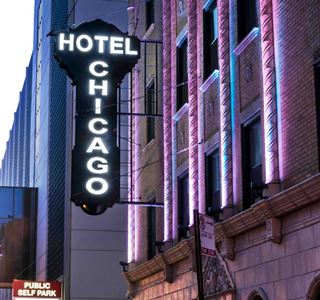
Chicago IL
Facts, Information and trivia
Elevation: Elevation 594 ft (181 m). Population 2,695,598 (2010).
Time zone: Central (CST): UTC minus 6 hours. Summer (DST) CDT (UTC-5).
Chicago is the only incorporated town in Cook County, Illinois, and the county seat.
History of Chicago
This marshy area where the Chicago River flowed into Lake Michigan was inhabited around eleven thousand years ago, when the ice sheets retreated north after the end of the last Ice Age leaving the Great Lakes in their wake.
Much later, the Native American Potawatomi tribe lived here, trekking across a short gap or "continental divide" between the Des Plaines and Chicago Rivers.
When the French explorers reached the area in 1673, rowing upstream along the Mississippi and Illinois Rivers their native guides showed them the portage point (now a National Historic Site, close to Lyons on Route 66).
Father Jacques Marquette and Louis Jolliet were the first Europeans to use it. The portage was a muddy slough 8 mi. long (13 km). La Salle explored the area later and realized its strategic importance and recommended establishing an outpost here.
France ceded the territories in the 1750s after a war with Britain and shortly after it became part of the U.S., following its independence from Britain. The Indians ceded the mouth of the Chicago River to the US by the Treaty of Greenville (1795), in 1803, U.S. soldiers erected fort Dearborn at the river's mouth, rebuilt it in 1816 (the natives had burned it down during the War of 1812).
In 1818, this territory incorporated into the Union as the state of Illinois. There was trading along the portage, but the roads were terrible. Chicago was platted in 1829 and incorported in 1833.
Cook County was created in 1835 and named after Daniel Pope Cook (1794 - 1827) newspaper editor and politician, he was the first Attorney General of Illinois, and later a congressman.

Cook County is the second-most populous county in America after Los Angeles County -and both lie on US 66.
Construction of the Illinois and Michigan Canal began in 1836 -it was completed in 1848. Dearborn Fort closed in 1837.
The town grew as a trade crossroads, a hub linking the north, the Mississippi, the Great Lakes and the east Coast. The Railroads in the mid 1800s fueled its growth and made it the gateway to the west.
The name "Chicago"
The first written record is "Checagou" by La Salle in 1685, he applied it to the river and portage, and it was the name of a wild onion plant that grew along its banks.
The city burned down during the Great Chicago Fire in Oct. 1871, that killed over 300 people and razed 3.3 square miles (900 ha) of the city leaving 100,000 people homeless.
Some Chicago Trivia
Chicago is the third most populous city in the U.S., and has more than 2.7 million residents, It is also the most populous city in the state of Illinois and the Midwest.
Almost 10 million people live in the Chicago metropolitan area making it the third-largest in the U.S.
Route 66 was aligned along Ogden Ave. in 1926 and remained there until 1977 when it lost its certification.
Chicago: Hotels and Motels nearby
Sponsored
Accommodation in Chicago
> > Book your hotel in Chicago
Find More Accommodation near Chicago along Route 66
Accommodation West of Chicago
On Alt US 66
- 32 mi. Romeoville
- 41 mi. Joliet
- 58 mi. Wilmington
Along Main US 66
- SW Suburbs of Chicago
- 22 mi. Willowbrook
- 29 mi. Bolingbrook
- 39 mi. Plainfield
- 79 mi. Dwight
- 99 mi. Pontiac
- 109 mi. Chenoa
- 131 mi. Normal
- 137 mi. Bloomington
- 156 mi. Atlanta
- 167 mi. Lincoln
- 199 mi. Springfield
- 235 mi. Raymond
Further West...
- 240 mi. Litchfield
- 264 mi. Staunton
- 266 mi. Williamson
- 272 mi. Hamel
- 276 mi. Edwardsville
- 285 mi. Troy
- 287 mi. Glen Carbon
- 292 mi. Collinsvile
- 293 mi. Pontoon Beach
- 298 mi. Fairmont City
- 302 mi. Granite City
- 302 mi. East St. Louis
>> See the RV campground to the south, in Joliet
Tip: It is not easy to find RV parking areas in Chicago it is not a very RV friendly city. Choose the outskirts.
The Weather
Where is Chicago?
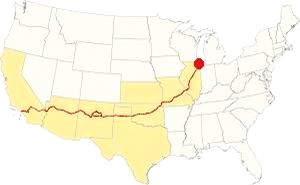
The climate of Chicago is classified as humid continental and has clearly marked seasons with hot and often humid summers, cool and wet springs, mild falls and cold winters.
Temperatures: Average high in Jan (winter) 31°F (-0.3°C) and the average low is 17°F (-8.6°C). Average high in Jul (summer) 84°F (29°C), with an average low of 64°F (17.7°C).
Precipitation: Rainfall is between 3 and 4.3 (78 and 110 mm) inch per month between April and November, falling to around 1.7 in. monthly (28 mm) during winter. Average rainfall is 36.82 inch (936 mm).
Snow: The city gets 28 inches of snow per year (71 cm), with the first snowfall usually taking place in November and the last one happening in April (with less than a quarter inch -8 mm). You shouldn't see snow from May to September.
Tornado risk
Cook County may get hit by around 4 tornados per year. Tornado Risk: read more about Tornado Risk on US 66.
How to get to Chicago?
You can get to Chicago driving along Historic Route 66 or I-55, from the freeway exit at Exit 283 There are other freeways in the area (I-355, I-290, I-57, I-90, I-94 and I-88). US 34, US 20 and US 45 also bring you to Chicago.
Map of Route 66 in Chicago, IL
Check out Chicago on our Route 66 Map of Illinois, with the complete alignment of Route 66 from 1926 till it was decertified, and through all the towns along it.
Maps with the alignment of Route 66 through Chicago
> > US 66 alignment into Chicago
> > US 66 alignment out of Chicago
Route 66 in Illinois: Historic U.S. 66 in Chicago
Route 66 across Illinois
Route 66 is a Historic highway and has also been designated as a National Scenic Byway and an All-American Road in the state of Illinois.
Read this detailed description of Route 66 in Illinois.
Below you will find More information on Route 66 in Chicago.
Chicago's Route 66 Landmarks and Attractions
What to see in Chicago, the "Windy City"
End and Begin Signs
Start your Chicago City Tour at the real Eastern Terminus of Route 66 in Grant Park:
Eastern Terminus of Route 66
Route 66 was created in 1926 to link Chicago with Los Angeles, and unlike the Interstate highways whose exits are numbered from west to east or from south to north, U.S. Highways don't have a beginning or an end, or do they?
Chicago: The starting point of Route 66
Even so, Chicago is considered as Route 66's "Starting Point": From here people headed west to seek new lives, jobs or vacations. The destination lay in the west... Santa Monica was the The Western Terminus of Route 66 or "End of the Trail" for Route 66. So Chicago was where it began.
Historic background
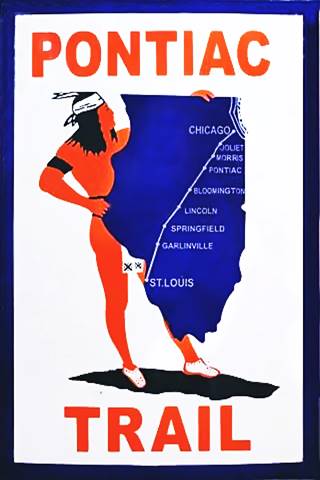
The Pontiac Trail symbol shield. www.ebay.com
The predecessor of Route 66 was the "Pontiac Trail":
As the use of automobiles grew in America during the early years of the 20th century, the demand for decent roads increased. Dirt trails with ruts were suitables for carts, not cars. So in 1915 the Pontiac Trail was created as a "solid surface road" built to link Chicago and St. Louis. It was named for the famous Ottawa Indians chief and the B.F. Goodrich tire company marked its milage posts; it even had its own shield sign (see image).
But private enterprise had limited resources, it was the state of Illinois who had to take responsibility for its highways, and it did so, by issuing a bond in 1918, and this was the origin of State Bond Issue (SBI) Route 4 aligned along the Pontiac Trail.
First starting point - State Hwy. 4
Joe Sonderman in his "Route 66 in Illinois" tells us that Illinois state highway 4 "was assigned to the route from Forty-eighth Street and Ogden in Cicero to East St. Louis", that is, where Harlem and Ogden meet on the border between Lyons and Cicero.
This highway ran south of this point, towards Lemont and then via Lockport to Joliet on the south side of the Des Plaines River. It was paved in 1923.
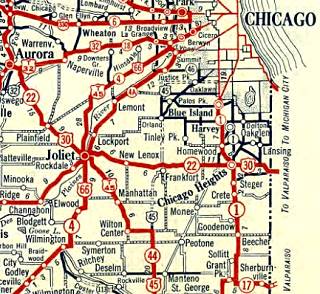
1928 Illinois State roadmap (see State Hwy 4A)
In 1926 another brand new paved alignment was built along the north side of the River between Joliet and Lyons through Romeoville, Willowbrook and McCook, becoming Route 4 (the older alignment became Route 4A -see map- modern Illinois Route 171).
Route 66 is created
When that same year, 1926, U.S. Highway 66 was created, it ran along the new IL-4 roadbed into Cicero.
According to Russell A. Olsen in "The Complete Route 66 Lost & Found", the eastern terminus at 48th St. and Ogden Ave. in Cicero was moved east into downtown Chicago in 1931, to Jackson St. and Michigan Ave. at Grant Park.
The State maps of 1926, 27 and 28 show Route 66 as continuing with IL-4 west of Cicero so perhaps its terminus was unclear to map makers.
Another change took place in 1957 when Jackson west of Michigan became one way (eastwards).
This meant that Westbound traffic from US 41 (which ran along Lake Shore Blvd.) drove along a "two lane" Jackson until reaching Michigan Ave, but then had to turn north and then again, west, along Adams St. to head westwards to reach Ogden Ave.
The 1956 Shell Oil Road map of Downtown Chicago, below, shows us a new Jackson Blvd. linking Michigan with Outer Drive (Route 66 ends at the red arrow):
1956 Shell Oil map of Downtown Chicago, Illinois
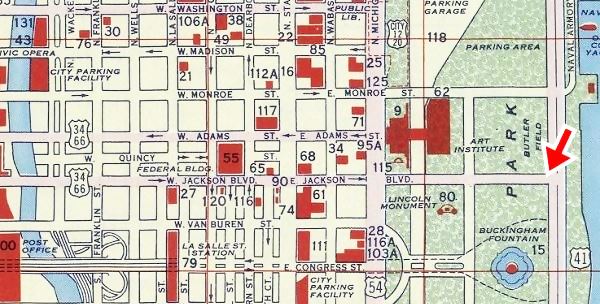
And this photograph taken in Grant Park, on Jackson Blvd. looking east towards Lake Shore Blvd, from the 1950s is more than eloquent with its white sign with black letters: "END OF ROUTE 34 -66":
End of US 66 and 34 1950s in Chicago, Illinois
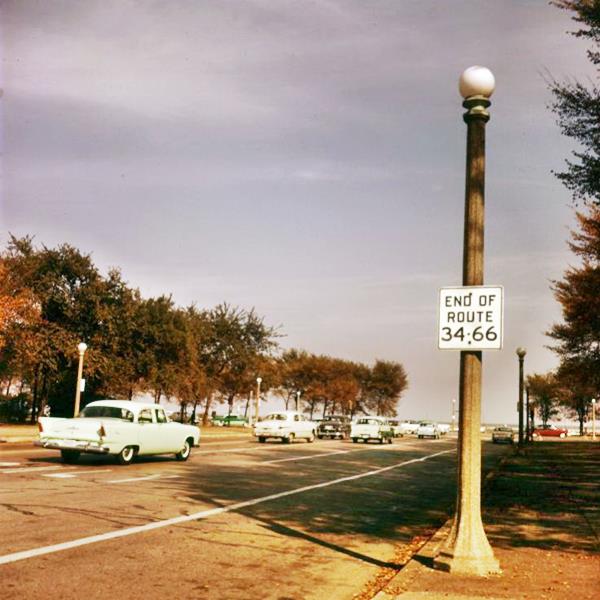
The "End" for Route 66
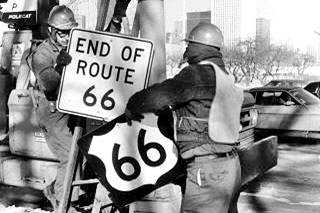
Route 66 shield being removed, Jan 1977, Chicago. www.66postcards.com
The signs were all removed when U.S. 66 was decertified. The signs in Grant Park were taken down on January 17. 1977 and there is a great photograph of this event (see image)
The image shows two workers removing the US 66 Shield and the "End of Route 66" sign on a chilly January day. In the background you can make out the Aon Center skyscraper (in those days it was the Standard Oil Building, completed in 1974).
New Beginning and New End Signs
The 1992 "Route 66 Law" or "U.S. Route 66 Designation Act" designated the existing portion of Route 66 in Illinois as a State historic highway. In consequence the former US 66 was marked with the typical brown signs across the state of Illinois, signs that include those at its Eastern Terminus, the road effectively got a new "start".
Route 66 'Begin' Sign
Don't miss the start "Begin" point at 99 E Adam St. (NW corner with Michigan Ave.):
Route 66 "Begin" sign, in Chicago, Illinois
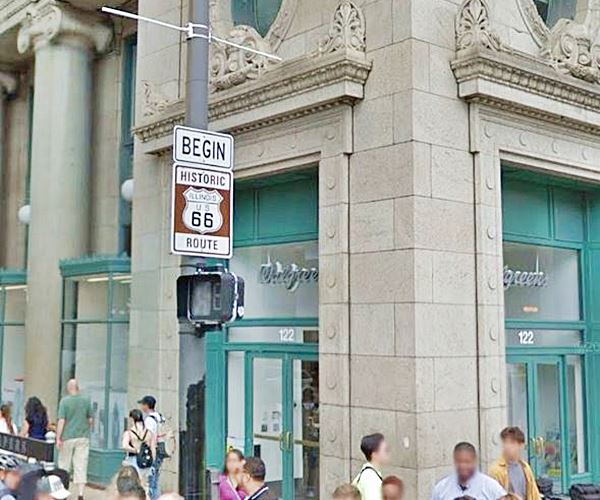
There is another "Begin" Sign on the opposite side of the street, just west of this one.
Route 66 'End' Sign
But as we said before, Route 66 also "Ended" in Chicago -for those driving eastwards, and the sign is there too, one block south, on E Jackson St. almost at Michigan Ave.:
Route 66 "End" sign, in Chicago, Illinois
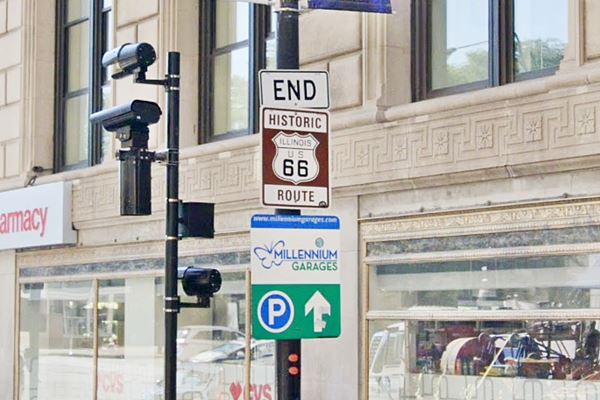

Grant Park a sight in itself
Sponsored
Listed in the National Register of Historic Places
This is the Eastern Terminus of Route 66. Here was the "End of Route 66 sign" where East Jackson Blvd. met US 41, by the shore of Lake Michigan.
It dates back to 1844 when it was created as Lake Park. In 1901 it was renamed after US President Ulysses S. Grant, and grew to its present size (319 acres or 1290 ha) through land reclamation projects.
It lies east of the built up area on Michigan Blvd. When the railroad was built along the shore of Lake Michigan, a lagoon was formed which was filled in to extend the park, which continued into the 20th century.
It is bound by Randolph Dr. and the Chicago River on the north, Lake Michigan on the east, Michigan Ave on the west and McFetridge Dr. on the south. Open from 9 AM in the morning daily.
The Art Institute of Chicago, the Adler Planetarium, Field Museum of Naural History and Shedd Aquarium are located in the park:
Adler Planetarium
1300 South Lakeshore Drive
It is America's first planetarium, built in 1930 on what was then an artificial island on Lake Michigan. More information at their website: adlerplanetarium.org
Shedd Aquarium
1200 South Lake Shore Drive
The world's largest indoor aquarium, with over 20,000 animals. More details visit: sheddaquarium.org
The Field Museum
1400 South Lake Shore Drive
A must-visit Natural History Museum, it holds "Sue" the World's largest T-Rex "Sue", Egyptian mummies and more! (like the The Benld Meteor which fell in 1938 in Benld on the 1926 US 66). Visit fieldmuseum.org fore more information.
Buckingham Fountain
Don't miss the Buckingham Fountain, 300 yards to the south of E. Jackson between S. Lake Shore Dr. and S. Columbus Dr., it was built in 1927, a local landmark.
One of the largest fountains in the world, it was modeled after the Latona Fountain at the Palace of Versailles of King Louis XIV of France, built between 1668 and 1689 it celebrates Apollo as a child, and his mother Leto or Latona (Zeus fathered her children Apollo and Artemis).
Buckingham Fountain in Chicago, Illinois

At the Park's northern "Cloud Gate" is the giant stainless steel sculpture by Anish Kapoor, also known as "The Bean".
The Loop
Continue your walking tour in "The Loop" (Chicago's central business district. Named after the cable car and elevated railway encircled the area like a "loop").
To your right (north) facing Michigan Ave., between W. Jackson and W. Adams is the Art institute.
The Art Institute of Chicago
111 South Michigan Avenue
With a large collection of Impressionist paintings it also has a Route 66 Exhibit.
Along Route 66 in Downtown Chicago
Across from the Art Institute on the west side of Michigan Ave. is the Orchestra Hall. As you turn the corner from Michigan into E Adams St. on the north side of the street is the famous BEGIN Historic Illinois US 66 shield on a light post, there is another one on the south side of Adams, half way down the block.
Ahead is the elevated railroad known as The Chicago "L" (short for "elevated") which dates back to the 1890s, and further ahead is a German Restaurant Berghoff's. Don't miss its neon sign.
Berghoff Restaurant
17 West Adams
This restaurant has been owned and operated by the Berghoff family since it opened back in 1898.
Berghoff neon sign and beyond to the right the "Sears" Tower in Chicago, Illinois

Ahead, to your right is the former Midland Hotel, now the "W Hotel":
Midland Hotel now W-Hotel
172 W Adams, Chicago
Now it is a luxury Starwood Hotel, the "W Chicago City Center Hotel" and its facade remained untouched.
You can Book a Room in the W Chicago City Center
The businessmen club named the Midland Club commissioned architect V. H. Vitzthun to build an Art Deco styled skyscraper. The tower combined offices and the club.
But the Crash of 1929 and the Great Depression that ensued upset the plan, most of the building's office space remained vacant. So in the mid 1930s, the club leased some of it to the Midland Hotel which ended up buying the building in the 1940s.

W-hotel, former Midland, Chicago, Il.

Midland Hotel vintage postcard, Chicago, www.cardcow.com
The vintage postcard described the Midland as "Chicago's 'friendliest' hotel, located in the downtown loop area... TV. Ticker Tape Lounge. Coffee Shop..." (Ticker Tape to follow your shares ups and downs!).
Continue westwards passing under the Elevated Railroad at Wells St. On the next block, at S. Franklin St. is the former Sears Tower:
Sears Tower
233 South Wacker Drive
Now named "Willis Tower", but best known as the Sears Tower; it is a 110-story building. It is 1,450 feet high (442 m) and when it was finished back in 1973 it became the tallest building in the world (overtaking the Twin Towers of the World Trade Center in New York). It eventually lost its title and now after the completion of the New World Trade Center building in NYC in 2014, it is the second tallest building in the US and the Western Hemisphere and the 16th on a global scale.
It was the work of architect Fazlur Rahman Khan, and is now named after Willis Group, who lease space in the skyscraper.
More than one million people visit its "Skydeck" observation deck each year: on the 103rd floor, 1,353 feet up in the air, with stunning vistas of Chicago (you can see a distance of 50 miles) and four states.
Drawbridge capital of the world
Cross the Chicago River's South Branch using the Original Bridge that carried Route 66, built in 1927 and rehabilitated in 1996, it is a Double Trunnion Bascule Deck Truss (Status: Open to traffic)
The Chicago River runs through Chicago, including its central downtown district. Over the centuries it evolved into a system of rivers and canals (now 156 miles or 251 km long).
It's flow was reversed and now instead of discharging into Lake Michigan, it flows west into the Mississippi River via the Illinois River.
The first bridge across it was built in 1832, and it peaked at 52 bridges in the 20th century. Now 38 remain, all of them different types of movable bridges.
One block past the river, to your left is Union Station (go inside to take a peek at its Beaux-Arts style facades with Corinthian columns, its lavish bronze lamps and the vast Hall).
Union Station Trivia
The shootout sequence with the baby's pram rolling down the stairs in the movie "The Untouchables" (1987) was shot here. Other movies filmed here include My Best Friend’s Wedding and The Sting.
Turn south along S. Clinton St. to W Jackson St. (the eastbound Route 66 into Chicago), and to your left on the south side of Jackson is the Historic Lou Mitchell's Restaurant:
Lou Mitchell’s Restaurant
Listed in the National Register of Historic Places - Neon Sign
565 West Jackson Boulevard
Strategically located on the former eastbound US 66 into Chicago, a few blocks from Lake Michigan and the eastern terminus of the Mother Road.
Historic Lou Mitchell’s Restaurant in Chicago, Illinois

The neon sign is the original one, from 1949, and it announces "Lou Mitchell's Serving the World's Best Coffee". Its facade with aluminium and glass is the original one, and most of its interior is also original and virtually unchanged.
It was founded by William Mitchell, who ran a restaurant on the other side of Jackson, back in 1923. He named it after his son Lou who worked hiere until he was in his seventies when he sold it to his niece. It is run by her family today.
Turn back and walk down Jackson to the "END" sign of Route 66 at Michigan Ave., and this is the end of your walking tour in "the Loop". Get your car and drive west to see some more of the few remaining Route 66 Landmarks in Chicago.
Sights and Attractions as you drive out of Chicago
Drive west along Adams St. and turn left when it meets Ogden Avenue. Here across the road, on the NW corner is a Vintage Gas Station:
Former Amoco Gas Station
1676 W Ogden Ave. Chicago
The photograph below in its credits tells us that this was a "Typical Standard Oil gas station" of the 1970s, it was strategically located on Adams St. and Ogden Ave., the photograph was taken on Dec. 24, 1976 shortly before Route 66 was decertified.
The place has been repurposed but its origin as a gas station cannot be denied, now it is the "Su Taqueria El Rey del Taco". The two garage bays to the right of the old office are now windows.
Amoco filling station 1976 photograph in Chicago, Illinois

Former Amoco filling station nowadays in Chicago, Illinois

Passing the overpass, to your left is W. Jackson St. which took the US 66 traffic into Chicago's Loop. Turn along it, and on the second block, to your left is a Classic Hotel:
Former Rosemoor Hotel
1622 W Jackson Blvd, Chicago
You can Book a Room in the Hotel Chicago
This hotel which is still open, now as the "Hotel Chicago" used to be the Rosemoor Hotel, which as listed in the 1961 Hotel Directory of Chicago, had 150 rooms from $4.00 and up. At that time it was owned by DeWoskin & Co and managed by John Temple. Later it fell on hard times and lodged Single Room Occupancy tenants until it was refurbished and modernised in 2014.
Its classic neon sign has been saved and still lights up the facade, but with the new name:

Neon sign of the old Rosemoor Hotel, Chicago, Il.
Return to Ogden Ave
Ogden Avenue
Ogden Ave. Chicago, Cook County
The name Ogden comes from the Old Enlgish words "ac" (oak) and "denu" (valley).
The throughfare was named for Chicago's first mayor: William Butler Ogden, this avenue runs for 37.5 miles (60.4 km) from Chicago (Chestnut St. near Milwaukee and Chicago Avenues) all the way to Naperville, IL
When Chicago was a fort on Lake Michigan (Fort Dearborn) in the early 1800s, the trappers used a muddy known as "Ottawa Trail" that linked the fort with what nowadays is Lisle.
The trail was improved and a stagecoach service was established, stopping at what now is Hinsdale in the 1830s, but the cart traffic ruined the dirt road, forming ruts. The trail was a muddy bog during the rainy season. Then some entrepreneurs built a toll road, the "Plank Road", which made traffic flow easily across the quagmire.
Plank Road
Construction began in 1848 and it was known as "The Southwestern Plank Road", it was the first of many that would radiate from Chicago. This one followed the trail to Lyons and in 1851 it was extended through Lisle to Naperville.
The road was built with wooden planks with log stringers on their outer edges. The boards were 3 in. thick and 8 feet wide -rather narrow.
Toll fees were charged ranging from 3¢ for one hog or sheep, 12¢ for a horse and rider to 37¢ for a cart drawn by four hourses.
When the Chicago, Burlington and Quincy railroad began operating in 1863, the traffic along the plank road declined.
It was re-named in 1877 as Ogden Avenue. The planks gone, it became a gravel surfaced road. But by the early 1900s the first cars appeared and by 1914 it had been paved becoming a main throughfare.
Route 66 and US 34 were aligned along it in 1926 and in the 1930s it was widened to four lanes.
Drive west along Ogden for 1.3 miles, and, to your right on the SW corner of Ogden and S Western Ave. is a vintage service station:
Former Mercury Oil gas station
1254 S Western Ave, Chicago
Former Mercury Oil gas station in Chicago, Illinois

The modern Goodyear - Interstate Auto Center (now a tire sale, muffler, tune up and repair shop) has a very interesting "cottage" style gas station building. It probably dates back to the 1930s and in 1941 it appeared listed in the Chicago Business directory as a Mercury Oil Company gas station.
Drive 2 miles towards the west to reach the next attraction (you will pass through Douglas Park which is one of Chicago's largest parks) beyond it is the Historic Castle Car Wash:
Castle Car Wash
Listed in the National Register of Historic Places
3801 W. Ogden

This building, on the SE corner of Ogden and Hamlin, was designed to look like a castle from the Middle Ages, was built in 1925 and is the only historic gas station on US 66 within Chicago's city limits.
It is rumored to have been one of Al Capone's hideouts.
John J. Murphy ran it as a gas station for over 40 years. In the 1970s it became a S&B Standard Service and in the 1980s a Car Wash.
This marks the end of your drive through Chicago so head west (south) along Route 66 into neighboring Cicero or visit some more Attractions in Chicago:
Some more Chicago attractions
360° Chicago
875 North Michigan Avenue, 94th Floor
Formerly John Hancock Observatory
This observatory offers some great views of the city from a height of 1,000 feet. Café on 94th floor. More info at their website: 360chicago.com.
Wrigley Field
1060 West Addison St.
Home of the Chicago Cubs, built in 1914, it is the second oldest ballpark in America.
The Chicago Theatre
175 North State St.
In Downtown Chicago it is a landmark. More at their website: thechicagotheatre.com
Historic Route 66 in Chicago, Illinois
Route 66
As we mentioned above (see Eastern Terminus of Route 66), Route 66's eastern tip is located in Chicago, its alignment is marked with a Pale Blue line in the map above.
Route 66 remained aligned on Ogden Ave. until its decertification in 1977. Below is a 1934 map of the highway in Chicago. US 66 with US 34 cross from the central left side of the image in a diagonal along Ogden and then turn along Jackson all the way to Grant Park on the right side of the map:
1934 road map of Route 66 showing Chicago
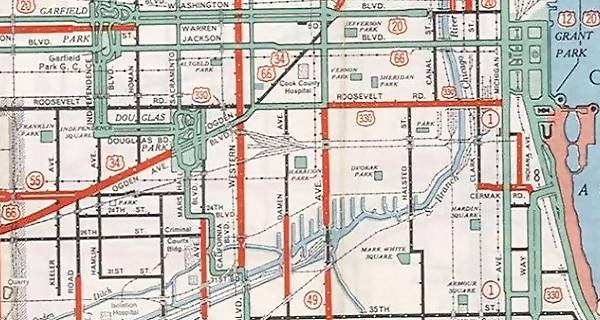
Route 66 into Chicago
The 1928 Illinois State Roadmap shows no urbanization along US-66 heading north into Chicago east of Joliet (which overlapped State Highway 4 and US "T"45) all the way into Chicago, the first town on the alignment. To the north lay Hinsdale and Lagrange, but the first town was Lyons, followed by Berwyn, Chicago and Chicago.
By 1945 (according to the Illinois state's official Highway map), things had changed, not oly had US 66 moved to a new alignment through Plainfield, now "Romeo" (yes, not "Romeoville") appeared on ALT 66 north of Lockport on the former 1926-1939 US 66 through Joliet. The urban sprawl reached Lyons, and to the west of it, there were no more towns until Plainfield.
The 1954 map shows the same picture but now US 66 from Chicago to IL-53 and then south as ALT 66 through Joliet and all the way to Wilmington was a "Four Lane Pavement" the main US 66 west of this point, through Plainfield and Braidwood was merely a "Two Lane Pavement".
There are changes in the 1959 state highway map: US-66 south (west) of its junction with ALT US 66 has become an "Expressway" with "highway separation" (overpasses and limited access). This freeway bypassed Plainfield and the former 1940 to 1958 US-66 alignment became state hwys. 126 and 59.
During the 1960's, the suburbs expanded and the 1969 state highway map now shows I-55 and US 66 running together eastwards all the way to the exchange with I-294. Splitting here: with I-55 taking a more southern course and US-66 a northern one.
Drive from Chicago to McCook along Route 66
It is a 7 mile drive along Route 66 from the "Eastern Terminus" of Route 66 in Chicago to Cicero: Map with directions.
> > See the next segment Cicero to Berwyn Illinois (west)
Some sponsored content
>> Book your Hotel in Chicago


Sources
Jack DeVere Rittenhouse, (1946). A Guide Book to Highway 66.
Banner image: Hackberry General Store, Hackberry, Arizona by Perla Eichenblat.


